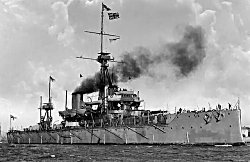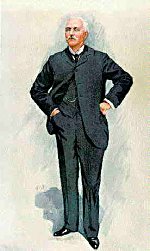
Sir Phillip Watts was born into a family of shipwrights on 30 May 1846 at Deptford, Kent. His father John, of Havelock Park in Southsea, was a master shipwright as had been his grand-father and great-grandfather, the latter being involved in the construction of HMS Victory. His mother was Mary Ann Featherstone.
Given the tradition in his family it was hardly surprising that young Philip was destined to build ships and after receiving an education at Portsmouth's formost school was apprenticed in 1860 as a shipwright in the royal dockyard. His ability was identified quickly and by 1866 was sent by the Admiralty to the Royal School of Naval Architecture and Marine Engineering at South Kensington. He left there in April 1870 with the title of fellow, and returned to the Admiralty where he was placed on the chief constructor's staff.
At the age of 26, Watts was sent to Pembroke Dockyard as assistant constructor during the building of the battleship Shannon, which was eventually launched in 1875. He attracted a reputation for ingenious design of all things maritime and this served him well when his return to the Admiralty he was asked to supervise a new section set up to control the evolving designs of ships. He remained at the Admiralty until 1885 when he resigned in order to take up the post of naval designer and general manager to Armstrong & Co. at their warship yard at Elswick.
The work at Elswick consisted primarily of contracts to build ships for foreign navies, and included Japan, Argentina, Brazil, Chile, Norway, Portugal, Romania, and Turkey. His ships were noted for their speed in relation to displacement and for their remarkable firepower. His designs were so successful that between 1904 and 1905 almost all battles engaged by the Japanese fleet were conducted from his ships, notably the battleships Yashima and Hatsuse, and the cruisers Idzumo, Iwate, Asama, and Tokiwa. One of his most famous ships was the cruiser Piemonte which he built for the Italian navy, making her one of the most heavily armed ships in the world.
In 1902 Watts was appointed director of naval construction at the Admiralty at a time when eight King Edward VII class of battleships were either under construction or on the drawing board. In the opinion of Watts the ships were not sufficiently powerful and he began a series of his own designs. The Admiralty did not take up his suggested improvements immediately but by 1905 the Lord Nelson and the Agamemnon were being built to his design. To some extent this was aided by a new First Sea Lord, in Sir John Arbuthnot Fisher who readily appreciated the effectiveness of Watts' designs. The two men had discussed naval design as far back as 1881 when Watts accompanied Fishers fleet in the Mediterranean. Watts proposals for battleships with a series of massive guns deployed in turrets had been rejected at the time because the weight of the guns would have significantly increased the displacement, but Fisher was keen to introduce such a concept. Specifically, the design called for 3 16 inch, 80 ton guns at both ends of the ship deployed in steps so that the ship could fire forwards backwards or in a broadside.
The proposal for a 12 gun battleship was accepted in principle by a high ranking committee under Lord Selborne but it was eventually rejected on the grounds of cost and the lack of dockyard capacity. What emerged was a design by Watts, typified by the battleship Dreadnought and the battle cruiser Indomitable, which offered more armaments for a given displacement, the use of steam turbines to increase speed, greater manoeuvrability and greater protection against attack, including the internal sub-division of the ship into watertight compartments. The Dreadnought had ten 12 inch guns, three pairs on the centreline and one pair each side amidships.

The 2 October 1905 saw the first Dreadnought laid down at Plymouth and she began sea trials a year later. She was the first of a series of classes of battleship designed by Sir Phillip Watts, namely, the Bellerophon, St Vincent, Neptune, Orion, King George V, Iron Duke, and Queen Elizabeth, each increasing in firepower and speed. The designs were set to become the most important over the entire globe. Watts' was praised by the Institution of Naval Architects who described him as "one of the world's great naval designers".
Though the battleships cemented his reputation, Watts' designs for battle cruisers were no less important and by 1914 almost all of those in service with the Royal Navy were designed by him. Indomitable, Inflexible, and Invincible were launched in 1907 to be followed by the Indefatigable class in 1909 and the Lion, Princess Royal, and Queen Mary in 1910. The later classes achieved speeds of 28 knots but by 1912 the Tiger had pushed this on to 30 knots. Not content with designing the larger ships Watts went on to make significant improvements to the designs of light cruisers and destroyers.

All the time that Watts was developing the dreadnoughts the country was at peace and some voices were heard to regret was what described as the build up to a naval arms race. Fortunately for Britain the launch of new ships continued for as the country was to find out in 1914, the Germans had not been idle, though the extent of their naval expansion did not match that in the Royal Navy. The contribution of Sir Phillip Watts to Britain's supremacy at sea was illustrated at the Battle of Jutland where 29 of the 34 British battleships and battle cruisers were of his design.
By the beginning of World War I Watts had resigned his Admiralty post and returned to Elswick as director of Armstrong, Whitworth and Co. His work was widely recognised by Universities and Institutions who showered him with honours not the least of which being his KCB which he received in 1905. Though his work had taken him far away from his family's roots in Portsmouth he was a frequent visitor to the Borough and in 1922 he was partially responsible for the rescue of HMS Victory which had been deteriorating in Portsmouth harbour for a hundred years. He helped restore the ship to her Trafalgar glories, often guided by old plans of the ship he inherited from his great-grandfather.
Watts had married Elise Isabelle in 1875 and had two daughters. He died of pneumonia on March 15th 1926 at his home in Chelsea and was buried in Brompton cemetery.
Adapted from the article by E. I. Carlyle, rev. Anita McConnell in the Dictionary of National Biography